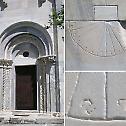The oldest sundial in Serbian lands
Only preserved Serbian medieval sundial is the one on the Virgin Mary (Bogorodicna crkva) church of Studenica monastery. Of all the Serbian monasteries Studenica has always been held in the highest respect. The church of the Virgin mary was built in the last two decades of the 12th century. In architectural conception and execution it ranks among the finest examles of what is know as the Raska style of church building.
Sundial is carved on the left pilistre next to the doorway of the south church vestibule, at about 4 m height. The semi-circle-shaped hour plate of 21 cm radius, is divided into 12 equal hour sectors. The sectors are numerated in Byzantine fashion by letters A, B, G, D, E, S , Z, H . There is missing the last quadrant of the sundial, the one with the denotations Q, I, IA, IB. There is no gnomon either, which must have been fixed perpendicularly on the wall, in the centre of the semi-circle shaped hour plate of the sundial (Fig. 1).
This kind of sundials with differing numbers of hour sectors (12, 8, 6, …) have been manufactured on a massive scale in the Middle Ages. One may say that they were one of the peculiarities of that period. Strictly speaking these were not the sundials in the exact meaning of the word since their shadow did not conform with the temporal hour system then in force. On the other hand these improvised devices have by themselves, through their geometrically ordered dials, dictated a particular division of the day which, considering its duration of several centuries, might be taken as a particular hour system: visual-temporal hour system.
The shape of the letters-numerals of the Studenica sundial suggests its being as old as the church itself, and this was built between 1183 and 1196.
No other medieval sundials have been preserved in the areas of Serbia and Serbian lands. Nevertheless their existence is indicated by numerous exact hour specifications in the medieval Serbian manuscripts. For fixing the first and the sixth – otherwise often mentioned – day’s hours no sundial was necessary, they having been linked with the sunrise and the noon. But the mentioning of the ninth, third, fifth and seventh hour does not leave any doubt as to their existence. For example the hour of death of the Serbian king Dragutin (1282, at the ninth hour), the second Serbian patriarch Sava (1375, at the third hour), the emperor Lazar (1389, at the sixth or seventh hour), the despot Stefan (1427, at five hours by day).
The piece of information from the annals to the effect that the first mechanical clock in Russia was installed at the Prince’s court in 1404 and that it was a work of the Serbian monk Lazar clearly betokens a tradition in Serbs of the clock workmanship. The medieval Serbian clock workmanship is atteszed to also by two sundials of „Studenica design“ found on Hungarian territory. One of these is at the locality Rackeve (Serbian Kovin) on the wall of the Orthodox church whose foundations were laid by Serbs. A similar one is on the Orthodox church in the village Grabocen. In their nortward mass migrations before Turks the Serbs carried with themselves in their memories also the Bysantine „recipe“ of sundial making.
Milutin Tadic (Gnomonica Italiana, 2004)
Source: manastirstudenica.rs





